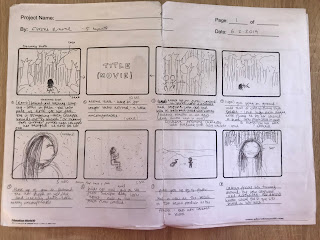(post 3a) The 3 act structure
(POST THREE A)
THE THREE ACT STRUCTURE
THE THREE ACT STRUCTURE
Act I - Setup
Act II - Confrontation
Act III - Resolution
Though some people like to call them beginning, middle and end, which is not accurate. The point of the three acts is to make sure that the story evolves and the stakes get higher.
Act I : Setup
 The first act is where all the major characters of the story are introduced, plus the world where they live in, and the conflict that will move the story forward. It must also present a strong hook - an exciting scene early in the script that grabs the audience's interest and hooks them. Part of that hook is the inciting incident that takes place somewhere in the beginning go Act I. This inciting incident often provokes a change in the protagonists routine- something new they experience that could either challenge or encourage them. Act I ends with the first plot point of the movie.
The first act is where all the major characters of the story are introduced, plus the world where they live in, and the conflict that will move the story forward. It must also present a strong hook - an exciting scene early in the script that grabs the audience's interest and hooks them. Part of that hook is the inciting incident that takes place somewhere in the beginning go Act I. This inciting incident often provokes a change in the protagonists routine- something new they experience that could either challenge or encourage them. Act I ends with the first plot point of the movie.
Act II : Confrontation
The second act is by far the longest, encompassing half of the movie and taking place between the first and third acts. At this point, the writer has created a solid frame for his/her narrative, yet sill roughly sixty pages away from the ending. In this act, the stakes escalate. If the hero is 'on the fence' or confused about what he should do, then something must happen by the midpoint of the script to make his goal clear. A pivotal element of this escalation inherent to Act II, which catapults the story into the third and final act. Much like Plot Point I, Plot Point II also affects the main character by changing the direction he's headed. The difference is that the stakes are much higher. This is often a moment of crisis, in which all hope seems lost.
Act III : Resolution
The last act, Act III presents the final confrontation of the movie, followed by the denouement (the final part of the play, the ending). This act is usually the shortest in length because quickly after the second turning point of the script, the main character is face to face with the villain or just about. Showdown ensues and then conclusion. This act is also when the writer ties up any loose ends and offers a resolution to the subplots. The resolution can also give extra information for a more elaborate character arc - the notion that characters =must evolve, grow, learn or change as the plot unfolds.
I have shown the three act structure in one of the short films that I have studied, I have clearly separated each act so that I can easily understand how this structure works, and how it is so commonly used in both short films and full-length. This short film is named 'The Fly', it is 6 minutes long, written and directed by Olly Williams, and stars Jack Doolan. Its synopsis is - A getaway driver waiting outside a bank robbery has three nerve shredding minutes to get through before his crew returns. All he has to do is focus…
I have shown the three act structure in one of the short films that I have studied, I have clearly separated each act so that I can easily understand how this structure works, and how it is so commonly used in both short films and full-length. This short film is named 'The Fly', it is 6 minutes long, written and directed by Olly Williams, and stars Jack Doolan. Its synopsis is - A getaway driver waiting outside a bank robbery has three nerve shredding minutes to get through before his crew returns. All he has to do is focus…
http://www.elementsofcinema.com/screenwriting/three-act-structure/
This video I found on youtube explains further the three act structure, its use in film and its importance. It shows how most of our favourite films use this structure.



Comments
Post a Comment